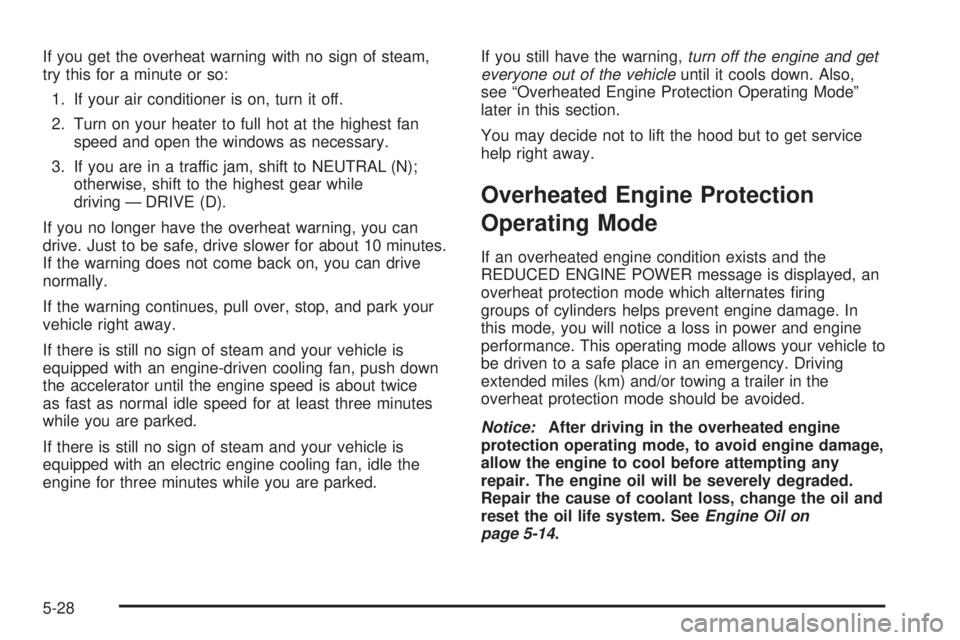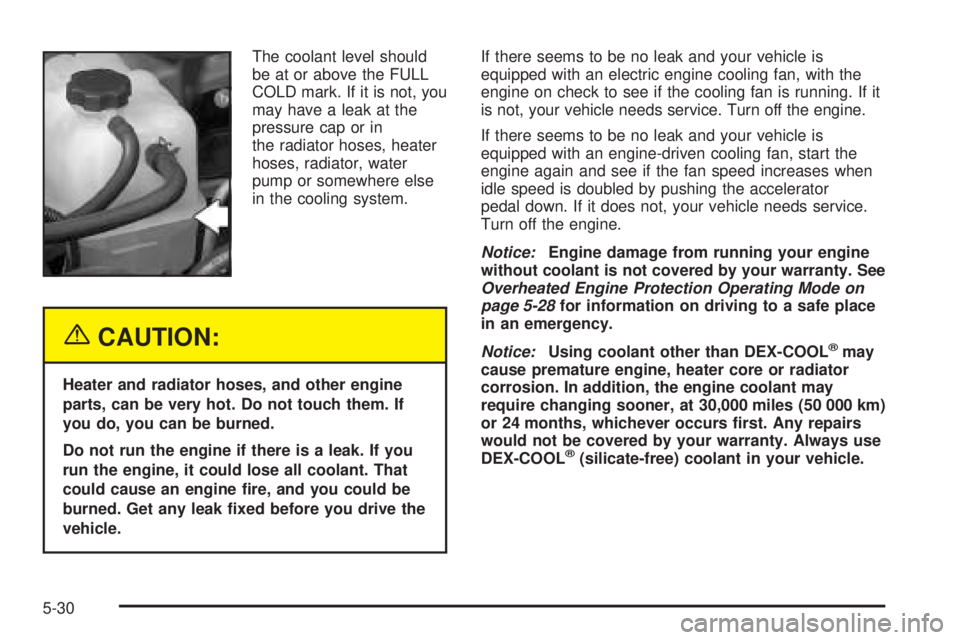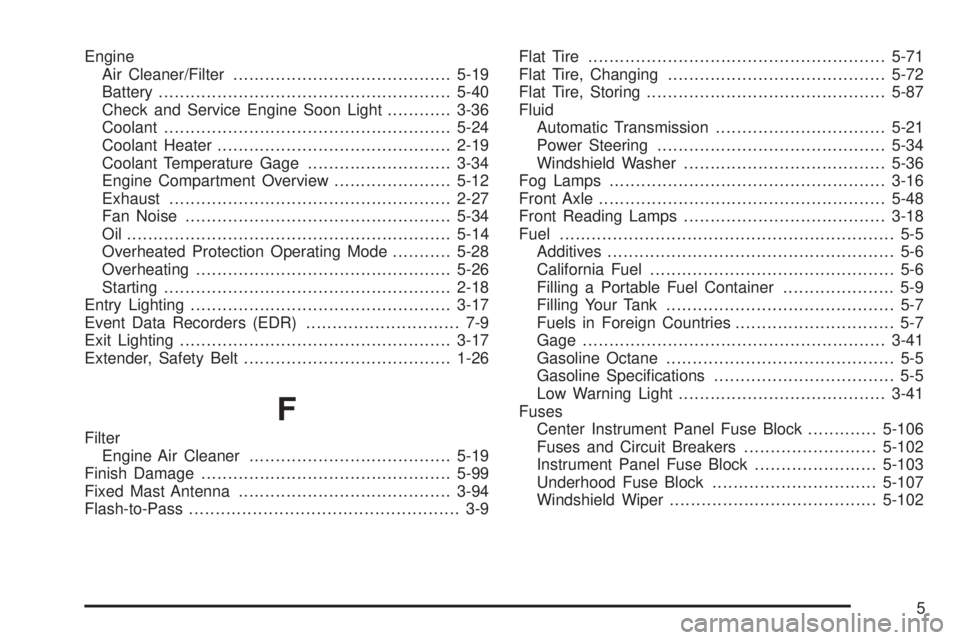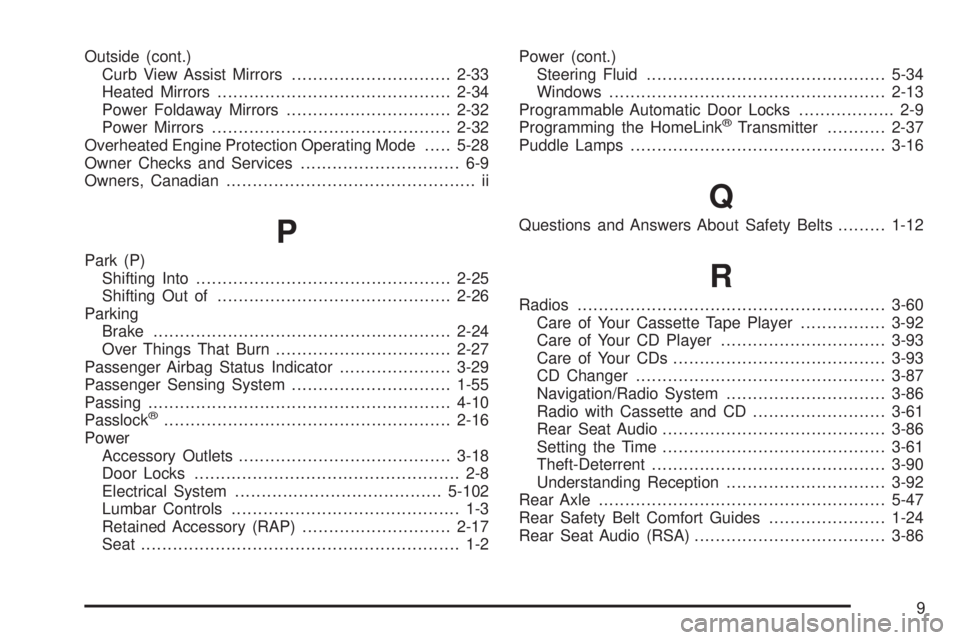2005 GMC SIERRA DENALI engine overheat
[x] Cancel search: engine overheatPage 300 of 428

If you get the overheat warning with no sign of steam,
try this for a minute or so:
1. If your air conditioner is on, turn it off.
2. Turn on your heater to full hot at the highest fan
speed and open the windows as necessary.
3. If you are in a traffic jam, shift to NEUTRAL (N);
otherwise, shift to the highest gear while
driving — DRIVE (D).
If you no longer have the overheat warning, you can
drive. Just to be safe, drive slower for about 10 minutes.
If the warning does not come back on, you can drive
normally.
If the warning continues, pull over, stop, and park your
vehicle right away.
If there is still no sign of steam and your vehicle is
equipped with an engine-driven cooling fan, push down
the accelerator until the engine speed is about twice
as fast as normal idle speed for at least three minutes
while you are parked.
If there is still no sign of steam and your vehicle is
equipped with an electric engine cooling fan, idle the
engine for three minutes while you are parked.If you still have the warning,turn off the engine and get
everyone out of the vehicleuntil it cools down. Also,
see “Overheated Engine Protection Operating Mode”
later in this section.
You may decide not to lift the hood but to get service
help right away.
Overheated Engine Protection
Operating Mode
If an overheated engine condition exists and the
REDUCED ENGINE POWER message is displayed, an
overheat protection mode which alternates �ring
groups of cylinders helps prevent engine damage. In
this mode, you will notice a loss in power and engine
performance. This operating mode allows your vehicle to
be driven to a safe place in an emergency. Driving
extended miles (km) and/or towing a trailer in the
overheat protection mode should be avoided.
Notice:After driving in the overheated engine
protection operating mode, to avoid engine damage,
allow the engine to cool before attempting any
repair. The engine oil will be severely degraded.
Repair the cause of coolant loss, change the oil and
reset the oil life system. SeeEngine Oil on
page 5-14.
5-28
Page 302 of 428

The coolant level should
be at or above the FULL
COLD mark. If it is not, you
may have a leak at the
pressure cap or in
the radiator hoses, heater
hoses, radiator, water
pump or somewhere else
in the cooling system.
{CAUTION:
Heater and radiator hoses, and other engine
parts, can be very hot. Do not touch them. If
you do, you can be burned.
Do not run the engine if there is a leak. If you
run the engine, it could lose all coolant. That
could cause an engine �re, and you could be
burned. Get any leak �xed before you drive the
vehicle.If there seems to be no leak and your vehicle is
equipped with an electric engine cooling fan, with the
engine on check to see if the cooling fan is running. If it
is not, your vehicle needs service. Turn off the engine.
If there seems to be no leak and your vehicle is
equipped with an engine-driven cooling fan, start the
engine again and see if the fan speed increases when
idle speed is doubled by pushing the accelerator
pedal down. If it does not, your vehicle needs service.
Turn off the engine.
Notice:Engine damage from running your engine
without coolant is not covered by your warranty. See
Overheated Engine Protection Operating Mode on
page 5-28for information on driving to a safe place
in an emergency.
Notice:Using coolant other than DEX-COOL
®may
cause premature engine, heater core or radiator
corrosion. In addition, the engine coolant may
require changing sooner, at 30,000 miles (50 000 km)
or 24 months, whichever occurs �rst. Any repairs
would not be covered by your warranty. Always use
DEX-COOL
®(silicate-free) coolant in your vehicle.
5-30
Page 304 of 428

{CAUTION:
Adding only plain water to your cooling
system can be dangerous. Plain water, or
some other liquid such as alcohol, can boil
before the proper coolant mixture will. Your
vehicle’s coolant warning system is set for the
proper coolant mixture. With plain water or the
wrong mixture, your engine could get too hot
but you would not get the overheat warning.
Your engine could catch �re and you or others
could be burned. Use a 50/50 mixture of clean,
drinkable water and DEX-COOL
®coolant.
Notice:In cold weather, water can freeze and crack
the engine, radiator, heater core and other parts.
Use the recommended coolant and the proper
coolant mixture.
{CAUTION:
You can be burned if you spill coolant on hot
engine parts. Coolant contains ethylene glycol
and it will burn if the engine parts are hot
enough. Do not spill coolant on a hot engine.
1. You can remove the
coolant surge tank
pressure cap when the
cooling system,
including the coolant
surge tank pressure
cap and upper radiator
hose, is no longer hot.
Turn the pressure cap slowly counterclockwise
(left) about one full turn. If you hear a hiss, wait for
that to stop. A hiss means there is still some
pressure left.
2. Then keep turning the pressure cap slowly, and
remove it.
5-32
Page 419 of 428

Engine
Air Cleaner/Filter.........................................5-19
Battery.......................................................5-40
Check and Service Engine Soon Light............3-36
Coolant......................................................5-24
Coolant Heater............................................2-19
Coolant Temperature Gage...........................3-34
Engine Compartment Overview......................5-12
Exhaust.....................................................2-27
Fan Noise..................................................5-34
Oil .............................................................5-14
Overheated Protection Operating Mode...........5-28
Overheating................................................5-26
Starting......................................................2-18
Entry Lighting.................................................3-17
Event Data Recorders (EDR)............................. 7-9
Exit Lighting...................................................3-17
Extender, Safety Belt.......................................1-26
F
Filter
Engine Air Cleaner......................................5-19
Finish Damage...............................................5-99
Fixed Mast Antenna........................................3-94
Flash-to-Pass................................................... 3-9Flat Tire........................................................5-71
Flat Tire, Changing.........................................5-72
Flat Tire, Storing.............................................5-87
Fluid
Automatic Transmission................................5-21
Power Steering...........................................5-34
Windshield Washer......................................5-36
Fog Lamps....................................................3-16
Front Axle......................................................5-48
Front Reading Lamps......................................3-18
Fuel............................................................... 5-5
Additives...................................................... 5-6
California Fuel.............................................. 5-6
Filling a Portable Fuel Container..................... 5-9
Filling Your Tank........................................... 5-7
Fuels in Foreign Countries.............................. 5-7
Gage.........................................................3-41
Gasoline Octane........................................... 5-5
Gasoline Speci�cations.................................. 5-5
Low Warning Light.......................................3-41
Fuses
Center Instrument Panel Fuse Block.............5-106
Fuses and Circuit Breakers.........................5-102
Instrument Panel Fuse Block.......................5-103
Underhood Fuse Block...............................5-107
Windshield Wiper.......................................5-102
5
Page 423 of 428

Outside (cont.)
Curb View Assist Mirrors..............................2-33
Heated Mirrors............................................2-34
Power Foldaway Mirrors...............................2-32
Power Mirrors.............................................2-32
Overheated Engine Protection Operating Mode.....5-28
Owner Checks and Services.............................. 6-9
Owners, Canadian............................................... ii
P
Park (P)
Shifting Into................................................2-25
Shifting Out of............................................2-26
Parking
Brake........................................................2-24
Over Things That Burn.................................2-27
Passenger Airbag Status Indicator.....................3-29
Passenger Sensing System..............................1-55
Passing.........................................................4-10
Passlock
®......................................................2-16
Power
Accessory Outlets........................................3-18
Door Locks.................................................. 2-8
Electrical System.......................................5-102
Lumbar Controls........................................... 1-3
Retained Accessory (RAP)............................2-17
Seat............................................................ 1-2Power (cont.)
Steering Fluid.............................................5-34
Windows....................................................2-13
Programmable Automatic Door Locks.................. 2-9
Programming the HomeLink
®Transmitter...........2-37
Puddle Lamps................................................3-16
Q
Questions and Answers About Safety Belts.........1-12
R
Radios..........................................................3-60
Care of Your Cassette Tape Player................3-92
Care of Your CD Player...............................3-93
Care of Your CDs........................................3-93
CD Changer...............................................3-87
Navigation/Radio System..............................3-86
Radio with Cassette and CD.........................3-61
Rear Seat Audio..........................................3-86
Setting the Time..........................................3-61
Theft-Deterrent............................................3-90
Understanding Reception..............................3-92
Rear Axle......................................................5-47
Rear Safety Belt Comfort Guides......................1-24
Rear Seat Audio (RSA)....................................3-86
9